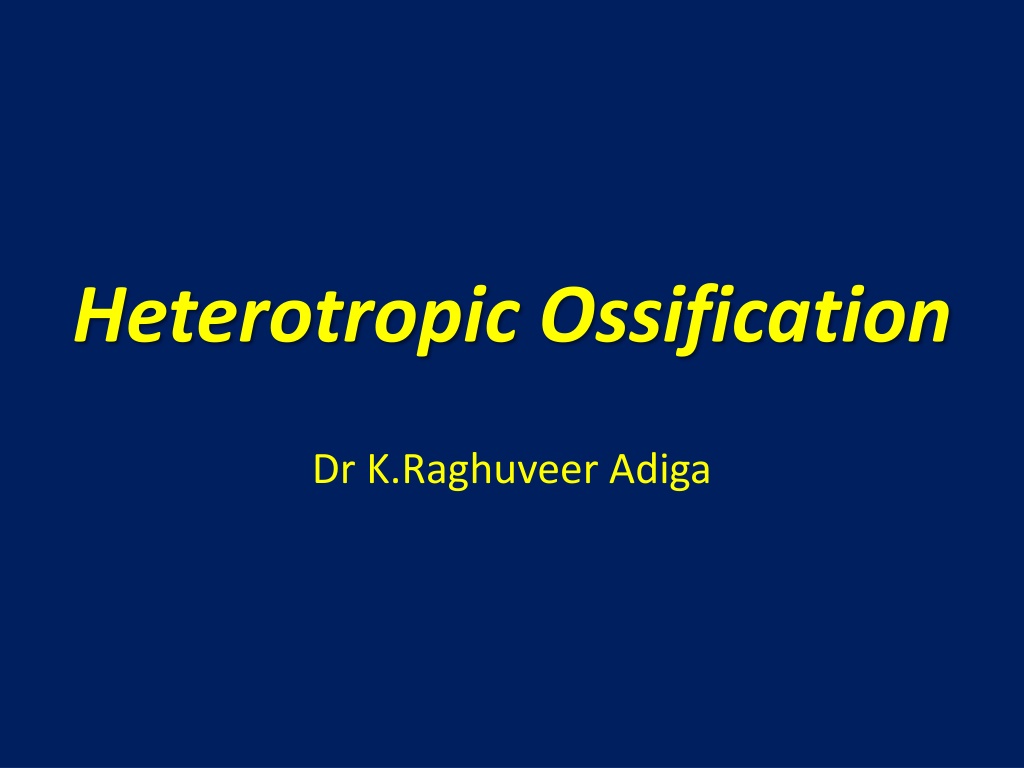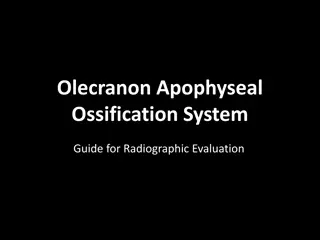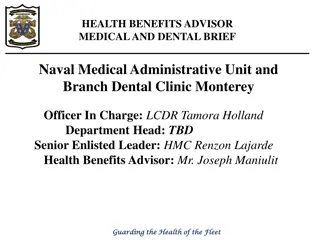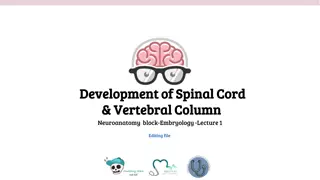Overview of Heterotopic Ossification in Medical Science
Heterotopic ossification (HO) is a phenomenon where bone forms in soft tissues outside the skeletal system. Initially observed in children with myositis ossificans progressiva, HO has been linked to trauma, neurogenic factors, and hereditary conditions like myositis ossificans progressiva. Clinically, HO presents with symptoms like fever, swelling, and decreased joint movement. Classification includes acquired and hereditary forms, with trauma and neurogenic causes being common. The grading of HO in the hip is based on a scale developed by Brooker. Understanding HO is vital for accurate diagnosis and management in clinical practice.
Download Presentation

Please find below an Image/Link to download the presentation.
The content on the website is provided AS IS for your information and personal use only. It may not be sold, licensed, or shared on other websites without obtaining consent from the author. Download presentation by click this link. If you encounter any issues during the download, it is possible that the publisher has removed the file from their server.
E N D
Presentation Transcript
Heterotropic Ossification Dr K.Raghuveer Adiga
Hetrotropic ossification was first described in 1692 by Patin in children with myositis ossificans progressiva Clearer description was provided by Reidel in 1883 Dejerine and Ceillier in 1918
During Ist World war, HO was predominantly observed in soldiers who had become paraplegic due to gunshot wounds.
Based on hypothetical etiopathogentic mechanism several terms used to denote this condition Ectopic ossification Myositis ossification Neurogenic ossifying fibromyopathy Paraosteoarthropathy Periarticular ossification
Myositis ossificans refers to a condition in which ectopic bone is formed within muscle and other soft tissues Robert(1968)reported HO in a patient with cerebral injury. Elbow was the involved joint.
Clinically: Fever, swelling, erythema Decreased joint movt seen in early HO which may mimic; Cellulitis Osteomyelitis Thrombophlebitis Osteosarcoma Osteochondroma
Classification Two versions: - Acquired - Hereditary Acquired form: A) Trauma:1) Fracture 2)THA 3)Direct muscular injury
B)Neurogenic:1) Spinal cord injury 2) Head injury Hereditary: Myositis ossificans progressiva
Heterotopic ossification of the hip is graded according to Brooker s Grading scale Grade 1. Islands of bone within the soft tissues about the hip. Grade 2. Bone spurs in the pelvis or the proximal end of the femur with at least 1 cm between the opposing bone surfaces. Grade 3. Bone spurs from the pelvis or proximal end of the femur with <1 cm between the opposing bone surface. Grade 4. Radiographic ankylosis.
Rare causes: Following burns Sickle cell anemia Hemophilia Tetanus Poliomyelitis Multiple sclerosis Toxic epidermal necrolysis
Incidences: Following THA 16% to 53% SCI 20% to 30% Closed head injury 10% to 20% Spastic limb 11% to 76% Usually HO forms after THA is minor and clinically not significant
Garland found that 89% joints involved were in spastic limbs Hip joint being most common
HO @ other sites: THA 16 to 53% TKA 9% Elbow 10 to 20%
Aetiology Extact cause is unknown Pleuripotential mesenchymal cells Osteoblasts This causes HO Bone morphogenetic protien differenitation of mesenchymal cells bone
Occur within 16 hours of surgery, peaks at 32 hours. Reaming bone marrow + traumatised well vascularized muscle HO.
Head injury patient needs ventilation Ventilation known to cause homeostatic changes of systemic alkalosis This modifies precipitation kinetics of calcium and PO4
Modifying pH at fracture sites Acidity to alkalinity More callus H O
Urist in 1978 discovered that dimineralised bone matrix could invoke bone formation ectopically and postulated a small (0.025mm) hydrophobic bone morphogenic protein the causative agent capable of changing mesenchymal cells in muscle from fibrous tissue to bone.
Chalmers (1975) described three condition necessary for HO formation 1) Osteogenic precursor cells 2) Inducing agents 3) Premissive enviornment
Contributory factors Hypercalcemia Tissue hypoxia Change in sympathetic nerve activity Prolonged immobilization Mobilization after prolonged immobilization Disequilibrium between PTH and calcitonin
Biochemical changes: Alk PO4 levels - 3 times at 4 weeks post injury PGE2 excretion in 24 hour urine-early indicator of HO
Histology: Myositis ossificans and HO are fundamentally different. Important steps in the ossification process is fibroblastic metaplasia.
Histological studies clearly demonstrates a zone of fibroblastic proliferation, followed by chondroblasts which eventually transformed into osteoblasts with blood vessels and haversian canals.
Diagnosis and Investigations Alk PO4 ase levels Three phase bone scintigraphy - Diagnostic and therapeutic follow up -very sensitive. - Usually positive after 2-4 weeks. - Serial bone scan helps to monitor of metabolic activity.
Radiography, MRI and CT scan Ultrasonography - < one week after THA
Treatment 1) Physiotherapy: -Assisted range of movement exercise with gentle stretch and terminal resistance training. -Joint movement not beyond pain free range
2) Medical management: NSAIDs Indomethacin 25mg tds for 6 weeks COX2 inhibitors:Meloxicam 7.5mg/15mg per day
Bisphosphonates retards the ossification when drug is stopped, osteoid gets mineralized Etidronate-300mg/day/IV for 3 days, then 20mg/kg/day for 6 months .
3) Radiation Therapy Extact mechanism is not known. Supposed to interfere with the differentiation of pleuripotent mesenchymal cells into osteoblasts.
Coventry and Scanlon(1970)-offered preventive radiation therapy for the first time at Mayo clinic before performing THA.
20 Gy in 10 fractions was the dose used initially because >20 Gy inhibited vertebral growth in children. Now 7 Gy in single fraction radiation found to very effective..
Timing Within 72hours after surgery. After 72 hours mesenchymal cells become differentiated. Pre -op Radiation vs Post operation Radiation 7 Gy 4 hrs before surgery vs 7Gy < 72 hours after surgery showed no difference in outcome.
Shielding the prosthetic device is very important during radiation therapy
Side effect of Radiation If the doses are 30 Gy and above, Radiogenic tumors induction Fertility problems
4) Surgical Treatment Only after HO has reached maturity HO become less metabolically active and has decreased rate of bone formation.
Garland(1991) has recommended schedules for surgical intervention. 6 months- after direct traumatic musculoskeletal injury 1 year-after spinal cord injury 1 years-after traumatic brain injury
6 months period is essential for bone to mature + distinct fibrous capsule to develop This minimizes trauma to surrounding structure Prevent hematoma formation Decreases local recurrences of HO
Complete wound lavage Avoid soft tissue trauma Remove all bone debris Reaming is also thought to decrease HO
Ghent university Protocol: Prior to THA or resection of HO, single dose radiation therapy given. NSAIDs given after surgery. Rationale of irradiation is to reduce pre-op and post-op bleeding. Post op irradiation not given.
Finally, HO Poorly understood condition Little known exact mechanism Development can be reduced by physio, NSAIDs and occasional radiotherapy. Excision may give good results. But there is risk of recurrence.























